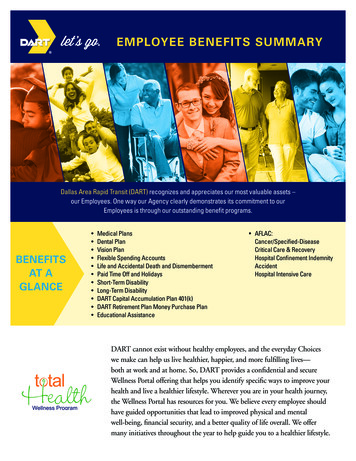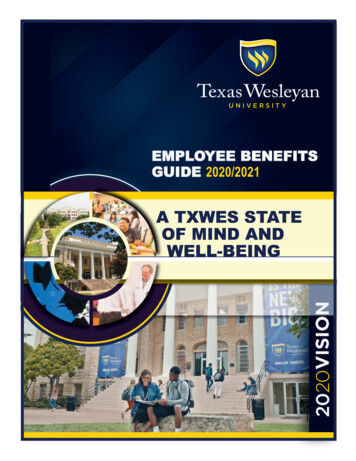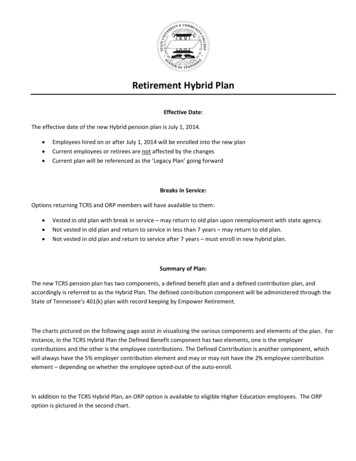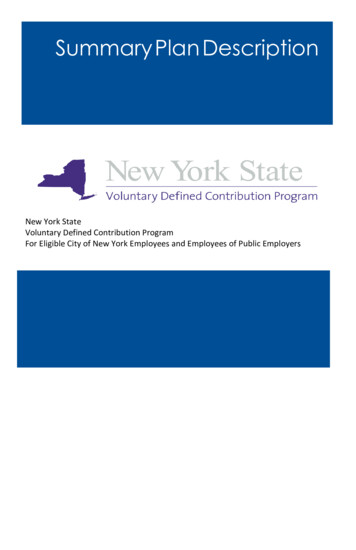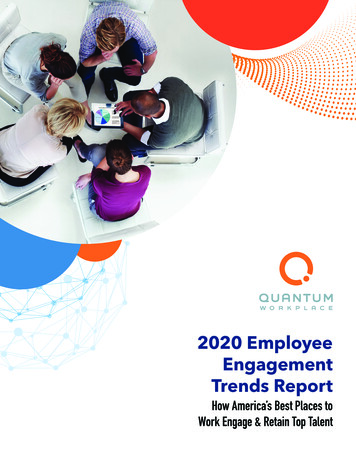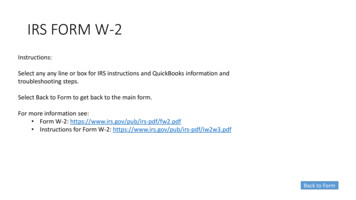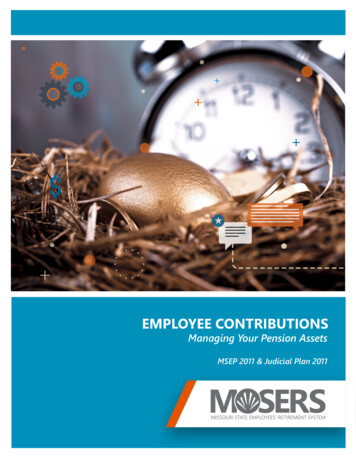
Transcription
EMPLOYEE CONTRIBUTIONSManaging Your Pension AssetsMSEP 2011 & Judicial Plan 2011
May 2022EMPLOYEE CONTRIBUTIONSManaging Your Pension AssetsMSEP 2011 & Judicial Plan 2011This publication summarizes provisions related to employee contributions to the retirement system. For more informationabout your pension benefits, please visit www.mosers.org.
EMPLOYEE CONTRIBUTIONSWe Are Here to HelpBenefit counselors are a valuable sourceof information regarding your benefitsand are available to assist you.Schedule an AppointmentSpeak with a benefit counselor by phoneor make an appointment to visit ouroffice. Our phones tend to be least busybetween 8:00 am and 9:00 am.Call Center HoursMonday Friday8:00 am–12:00 pm1:00 pm–4:30 pmContact UsToll Free: (800) 827-1063In Jefferson City: (573) 632-6100Fax: (573) 632-6103Visit Us907 Wildwood DrJefferson City, MOMailing AddressPO Box 209Jefferson City, MO 65102-0209Websitewww.mosers.orgLog in to myMOSERS to access yourpersonal information, submit forms,and more.Connect with Us on Social MediaBe sure to follow us on social media. It’s a greatway to stay informed and learn about your MOSERSbenefits. Invite your coworkers to join us, too!2Employee ContributionsWhen MOSERS was first established in 1957, by law, stateemployees contributed 4% of their pay to the System. In 1972,following a period of no or very modest pay raises for stateemployees, policy makers eliminated employee contributions inlieu of giving employees a pay raise.In 2010, following the Great Recession, the Missouri GeneralAssembly made changes to pension plans. That legislationreinstated employee contributions at 4% of gross pay on abefore-tax basis for members first employed by the state onor after January 1, 2011. It also increased the retirement age.However, state employees retained the valuable defined benefitplan structure.These changes have already produced cost savings. They willcontinue to reduce overall pension costs for the state goingforward, helping to ensure MOSERS’ sustainability over the longterm.Currently, more than 50% of active state employees contribute4% of their pay to the System.You can learn more about MOSERS’ funding on our website.
EMPLOYEE CONTRIBUTIONSTable of ContentsPlan Membership & Funding OverviewYour Defined Benefit Plan.4Funding Your Retirement System.4Managing Your Pension AssetsContribution Beneficiary Designations.5Leaving Your Employee Contributions with MOSERS.5Requesting a Refund of Your Employee Contributions.6If you are viewing a PDF of this brochure, usethe links provided in blue to quickly locaterelevant or additional information abouta topic. Click on any topic in the table ofcontents to go directly to that page.Taxes and Your Refund .7Requesting a Refund for a Deceased Member.7Summary.8The rules governing withdrawal of your employee contributions are contained in state retirement law and federal laws and rules.This publication is a summary, written in non-legal terms. It is not a complete description of the law. If there are any conflictsbetween what is written in this publication, and what is contained in the law, the applicable law will govern. For financial adviceand/or tax information, you should consult an accountant, other qualified financial adviser, or the IRS.3
EMPLOYEE CONTRIBUTIONSPlan Membership & Funding OverviewYour Defined Benefit PlanFunding Your Retirement SystemMSEP 2011 and the Judicial Plan 2011 are both definedbenefit plans. What does that mean? A defined benefit planis a retirement plan, sponsored by your employer that usesa formula to calculate the amount of your future pensionbenefit. Defined by law, the formula includes your length ofservice and your final average pay. Once vested, your ageand years of service will determine when you are eligiblefor retirement.As a member of MSEP 2011 or the Judicial Plan 2011,you are required to contribute 4% of your pay, by payrolldeduction, to the Missouri State Employees’ RetirementSystem (MOSERS) trust fund. Your contributions, along withcontributions from your employer and MOSERS’ investmentearnings, are three sources used to pay pension benefits.Additionally, a defined benefit pension plan is different fromother retirement funds, like retirement savings accounts,where the amount you receive at retirement depends onyour personal investment returns. MOSERS invests thecontributions it receives, manages the portfolio, and bearsthe risk. Regardless of how the investments perform, youare guaranteed a monthly pension benefit, for your lifetime.Annually, you will also receive a cost-of-living adjustment(COLA) of 0-5% in onsInvestmentsMoney to pay pension benefits comes from three sources:contributions from employers, contributions from employees,and investment earnings.4
Managing Your Pension AssetsEven if employed for just a few years, the service credit youearn as a member of MOSERS is a valuable asset. Oncevested, your MOSERS pension is guaranteed for life, does notlose value, and includes a cost-of-living adjustment (COLA) of0-5%. So, if you decide to leave state employment, carefullyconsider what to do with the contributions you have madeto MOSERS’ trust fund. Your decision can affect your futurefinancial security.Contribution Beneficiary DesignationsCertain life events may impact your pension benefits. If youhave not done so already, designate a beneficiary to receiveyour employee contributions if you die prior to retirement. Besure to keep MOSERS updated and make necessary changes(as allowed by law) to your beneficiary(ies) if you marry,divorce, or your spouse dies.To add or change your beneficiary(ies), log in to myMOSERSand submit a Contribution Beneficiary(ies) form. Yourdesignation will become effective when the completedform is received by MOSERS during your lifetime. Keep thefollowing in mind when designating a beneficiary. You may designate a person, trust, organization or estateas beneficiary. If you make contributions to the System, you or a survivoror beneficiary, will receive, at minimum, a benefit or refundin an amount equal to what you contributed, and anyinterest credited thereon, less any benefits received. Your surviving spouse will automatically become thebeneficiary of any contributions, plus any interest, madeby you to MOSERS, if you do not have a ContributionBeneficiary(ies) form on file at MOSERS. If you do not have a surviving spouse, the assets in youraccount will be distributed in the following order of priorityupon your death.––––Surviving children, divided equally (includes legallyadopted children)Surviving parents, divided equallySurviving brothers and sisters, divided equallyEMPLOYEE CONTRIBUTIONS Naming a minor (a person under the age of 18, exceptan emancipated minor) or estate as your beneficiary mayrequire that a conservator or other legal representative beappointed by a court before any payment can be issued. If you fail to complete and submit a ContributionsBeneficiary(ies) form, it could delay payment.Leaving Your Employee Contributionswith MOSERSYou are not required to withdraw your employeecontributions if you leave the state. You may leave yourcontributions with MOSERS if you think you may return tostate employment in the future.Vested MembersIf you are vested and choose to leave your contributions withMOSERS, you will be eligible for a future pension benefitonce you meet both the age and service requirements.MOSERS will continue to pay interest on your contributionsuntil you either withdraw the funds or reach normalretirement eligibility. Interest is compounded annually onJune 30 based on the balance in your account as of theprevious July 1. Interest is calculated using the 52-weektreasury bill rate.If you return to state employment and you left yourcontributions intact, your prior service will be restored.Non-Vested MembersIf you leave state employment prior to becoming vested, youwill not be eligible for a future pension benefit and interestwill not continue to accrue on your contributions.If you return to a position covered by MOSERS or theMissouri Department of Transportation & Patrol Employees’Retirement System (MPERS) and you left your contributionsintact, your previous service credit will be combined with yournew service credit to qualify for retirement. You will resumemaking employee contributions. If you are not vested, we willcombine your prior service with your new service once youhave completed 12 continuous months of employment.Estate5
EMPLOYEE CONTRIBUTIONSRequesting a Refund ofYour Employee ContributionsYour contributions to MOSERS are not available for loansor partial withdrawals. However, if you no longer work in aMOSERS benefit-eligible position, you may be eligible torequest a refund of your contributions. You are not eligible toreceive a refund if the following applies: Roll over a portion of your employee contributions, plusany interest, to a qualified retirement account and havethe remainder paid directly to you in a lump sum.–– Your retirement benefit is subject to a division of benefitorder (DBO) pursuant to section 104.1051, RSMo. You are currently receiving long-term disability (LTD)benefits. You are eligible for retirement.By taking a refund, you will lose all your credited serviceand future rights to receive pension and LTD benefits fromMOSERS. If you think you may apply for LTD, please contact aMOSERS benefit counselor prior to requesting a refund.To request a refund, complete the Member Request forRefund of Employee Contributions form, have it notarized,and submit it to MOSERS. The law prohibits MOSERS frompaying refunds until 90 days after the date of terminationof employment or the request, whichever is later. After the90-day waiting period, allow 60 days for MOSERS to processyour request.Options for Receiving Your Refund Roll over your employee contributions, plus any interest,to a qualified retirement account.–––6To roll your distribution over to MO Deferred Comp,your account must be active (you have not closed itsince leaving state employment).Taxes will be deferred on the employee contributionsyou roll over.Federal tax rules may prohibit you from rolling overthe entire lump-sum balance. If the IRS requiresyou to take a minimum distribution, MOSERS willautomatically calculate and issue the cash portiondirectly to you.––To roll your distribution over to MO Deferred Comp,your account must be active (you have not closed itsince leaving state employment).Taxes will be deferred on any contributions youroll over to a qualified retirement account. For theremainder paid directly to you in a lump sum, IRS rulesrequire MOSERS to withhold 20% for federal incometax (unless the amount is less than 200). You will beresponsible for any state, local, or other taxes that mayapply.If you are younger than 59½, a 10% early distributiontax penalty may apply.Federal tax rules may prohibit you from rolling overthe ENTIRE lump-sum balance. If the cash portionof your distribution is less than the IRS minimum,MOSERS will automatically calculate and issue theIRS “required minimum distribution” of cash directlyto you. Elect to receive the entire amount of the refund in a cashpayment.–––If you withdraw your money, IRS rules require MOSERSto withhold 20% for federal taxes unless the amount isless than 200.If you are younger than 59½, a 10% early distributiontax penalty may apply.If you take any of your refund in cash, it will be taxedin the year you receive payment. You will receive aForm 1099-R from MOSERS for tax filing purposes. Seethe Taxes and Your Refund section of this brochure foradditional information.
EMPLOYEE CONTRIBUTIONSTaxes and Your RefundRequesting a Refund for a Deceased Member Before requesting a refund, read the Special Tax Notice.It is included with your refund form and is available onour website.If you are entitled to receive a refund of employeecontributions from MOSERS because of a member’s death,you must complete, sign, and notarize the BeneficiaryRequest for Refund of Employee Contributions form. Withdrawal of contributions may carry a substantialtax liability. Any refund not directly rolled over will be reportedas taxable income in the year of payment. MOSERS isnot liable for any taxes incurred by you as a result ofthis distribution. Generally, the taxable portion of a single-sum distributionfrom an eligible plan is subject to mandatory 20% federalincome tax withholding and may be subject to a 10%IRS penalty if you are younger than age 59½, unless youauthorize a direct rollover to another eligible retirementplan or IRA. Since you may also owe state taxes on thisdistribution, you may request that MOSERS withhold forstate taxes as well. Any MOSERS-paid interest on your contributions istax-deferred. If you choose to transfer or roll overcontributions to an IRA or eligible retirement plan, thatentity must agree to accept it. MOSERS staff is not authorized to give tax advice. Youmay wish to consult with a professional tax advisor beforewithdrawing your contributions and before deciding howto take payment of your tax-deferred funds. You can find more detailed information on the federaltax treatment of payments from employer plans in:IRS Publication 575, Pension and Annuity Income; IRSPublication 590A and 590B, Individual RetirementArrangements (IRAs); and IRS Publication 571, Tax-ShelteredAnnuity Plans (403(b) Plans). These publications areavailable from a local IRS office, at www.irs.gov, or bycalling (800) TAX-FORM or (800) 829-1040. Surviving spouse – As the surviving spouse of adeceased member, your rollover options are the sameas the member.If you choose to roll over the refund to an IRA, you mayassume the IRA as your own or as an inherited IRA. AnIRA you assume as your own will be subject to the 10%additional income tax on early distributions on paymentsmade to you before you are age 59½ (unless an exceptionapplies). Required minimum distributions start after youare age 72. Surviving beneficiary other than a spouse – As thesurviving beneficiary other than a spouse, you may choosea direct rollover to an IRA. Payments from the IRA arenot subject to the 10% additional income tax on earlydistributions. Minimum distributions from the inherited IRAare required if the deceased member would have been age72 or older. Nonresident alien – As a nonresident alien, if you you donot elect a direct rollover to a U.S. IRA or U.S. employerplan, MOSERS is required to withhold 30% for paymentof federal taxes. If the amount withheld exceeds theamount of tax you owe (as may happen if you do a 60day rollover), you may request an income tax refund byfiling Form 1040NR and attaching your Form 1042-S.See Form W-8BEN for claiming you are entitled to areduced rate of withholding under an income tax treaty.See IRS Publication 519, U.S. Tax Guide for Aliens, and IRSPublication 515, Withholding of Tax on Nonresident Aliensand Foreign Entities for more information.If you take any of your refund in cash, it will be taxed in theyear you receive payment. You will receive a Form 1099-Rfrom MOSERS for tax filing purposes. See Taxes and YourRefund for additional information.7
EMPLOYEE CONTRIBUTIONSSummary The service credit you accumulate with MOSERS is avaluable asset. Once vested, your MOSERS pension isguaranteed for life, does not lose value, and includes acost-of-living adjustment (COLA) of 0-5% in retirement.Contribution Beneficiary(ies) Your 4% contributions help pay the cost of your futurepension benefit and could potentially pay you back farmore than you contributed. You may choose to take a refund or leave yourcontributions with MOSERS if you leave state employment.–A refund includes your contributions and any interest.Taxes may apply. You are not eligible for a refund if:–––You are receiving long-term disability (LTD) benefits.Your pension benefit is subject to a division of benefitorder (DBO) due to a divorce.You are eligible for normal retirement. You forfeit all your credited service and future rightsto receive pension benefits from MOSERS if you takea refund. If you left employment because of illness or disability,check with a MOSERS benefit counselor before requestinga refund of contributions. To request a refund, you and your spouse, if applicable,must complete, sign, and notarize the Member Request forRefund of Employee Contributions form. There is a 90-day waiting period from your date oftermination or the request (whichever is later). After the90-day waiting period, allow 60 days for MOSERS toprocess your request. The refund of contributions becomes irrevocable the dayMOSERS mails or electronically transfers payment. Submit a Contribution Beneficiary(ies) form to keep yourbeneficiaries current. To restore the service credit you forfeited by taking arefund, you must return to work as a state employee ina benefit-eligible position, work continuously for at leastone year, and repay the previously refunded amount,plus interest, at a rate established by the MOSERS Boardof Trustees.8Do you have a new email? Have you, or your beneficiaries,changed names or moved? Recently married or divorced? Forthese reasons, it is important to periodically review and updateyour information on file with MOSERS.To review or make changes to your beneficiary designations,log in to myMOSERS or contact a benefit counselor to requestpaper forms be mailed to your address.
PO Box 209 Jefferson City, MO 65102(573) 632-6100 (800) 827-1063Visit us at 907 Wildwood Drive or online at www.mosers.org.Contact MOSERS if you need an alternative format of this publication.
benefits. Invite your coworkers to join us, too! Employee Contributions When MOSERS was first established in 1957, by law, state employees contributed 4% of their pay to the System. In 1972, following a period of no or very modest pay raises for state employees, policy makers eliminated employee contributions in lieu of giving employees a pay .
